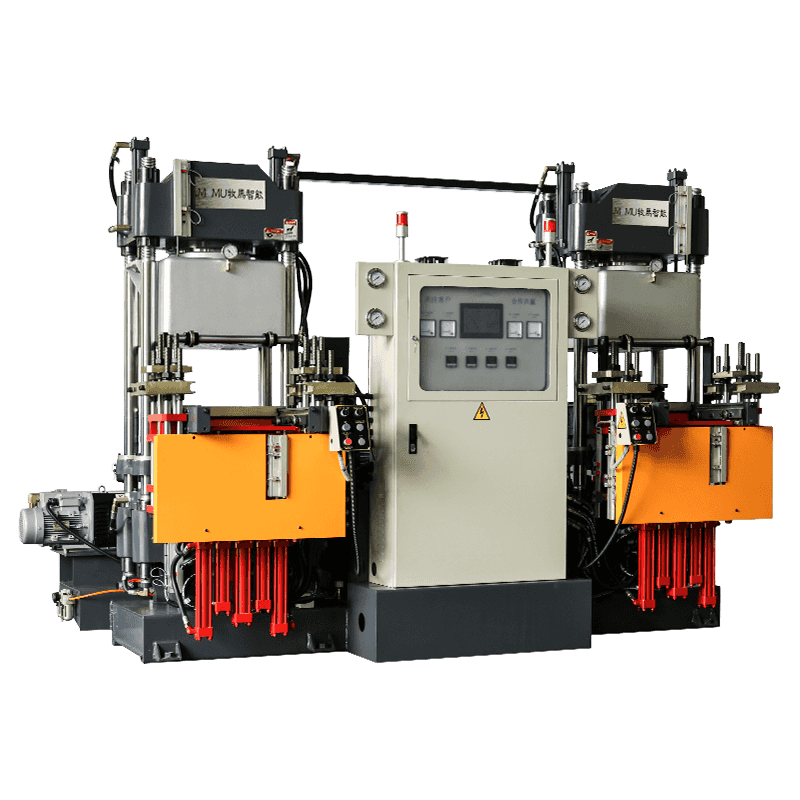There are several common issues that may arise with vacuum compression molding machines, along with troubleshooting tips to address them and maintain optimal performance. Here are some common issues and corresponding troubleshooting tips:
Poor Vacuum Pressure:
Issue: Insufficient vacuum pressure during the molding process can lead to incomplete filling of the mold cavity and poor part quality.
Troubleshooting Tips:
Check for leaks in the vacuum system, including hoses, seals, valves, and connections, and repair or replace damaged components.
Clean or replace vacuum filters, screens, and traps to ensure unrestricted airflow and maximum vacuum efficiency.
Verify that the vacuum pump is operating correctly and has adequate suction capacity for the size and complexity of the mold.
Uneven Heating or Temperature Variations:

Issue: Variations in mold temperature or uneven heating of the platens can result in inconsistent part quality and dimensional accuracy.
Troubleshooting Tips:
Inspect heating elements, thermocouples, and temperature sensors for damage, corrosion, or poor contact, and replace as needed.
Check for proper insulation and thermal conductivity between heating elements and mold surfaces to ensure uniform heating distribution.
Calibrate temperature controllers and adjust setpoints as necessary to maintain the desired temperature profile throughout the molding cycle.
Mold Release Problems:
Issue: Difficulty releasing molded parts from the mold cavity can occur due to inadequate mold release agents or improper mold surface treatments.
Troubleshooting Tips:
Apply a suitable mold release agent to the mold surfaces before each molding cycle to facilitate easy part release and minimize sticking.
Clean mold surfaces regularly to remove residual mold release agents, contaminants, or buildup that can interfere with part ejection.
Ensure proper mold surface preparation, such as polishing, sandblasting, or texturing, to enhance mold release properties and prevent part adhesion.
Warping or Distortion of Molded Parts:
Issue: Warping, distortion, or shrinkage of molded parts can occur due to uneven cooling, inadequate venting, or improper material flow in the mold cavity.
Troubleshooting Tips:
Optimize mold design and gating configurations to promote uniform material flow, minimize air entrapment, and facilitate even cooling of the parts.
Increase mold venting or add additional vents to allow trapped air to escape more effectively during the molding process.
Adjust molding parameters, such as temperature, pressure, and cycle time, to optimize part quality and minimize the risk of warping or distortion.
Excessive Flash or Mold Overflow:
Issue: Excessive flash or mold overflow around the parting lines of the mold can result from overfilling of the cavity, inadequate mold clamping, or worn mold surfaces.
Troubleshooting Tips:
Reduce injection pressure or material flow rate to prevent overfilling of the mold cavity and minimize flash formation.
Ensure proper mold alignment and clamping force to maintain tight seals and prevent material leakage during the molding process.
Inspect mold surfaces for signs of wear, damage, or misalignment, and repair or replace worn components as needed to prevent flash formation.
Machine Malfunctions or Faults:
Issue: Mechanical or electrical malfunctions, such as jammed mechanisms, sensor errors, or control system failures, can disrupt machine operation and production.
Troubleshooting Tips:
Conduct regular preventive maintenance checks to identify and address potential issues before they escalate into major malfunctions.
Consult the machine's service manual or technical documentation for troubleshooting procedures and fault diagnosis guidelines.
Contact the manufacturer's technical support or a qualified service technician for assistance in diagnosing and resolving complex machine faults.
By addressing these common issues and implementing proactive troubleshooting measures, you can maintain optimal vacuum compression molding machine performance, minimize downtime, and ensure consistent production of high-quality molded parts. Regular monitoring, maintenance, and adjustments are key to maximizing machine reliability, efficiency, and longevity.





